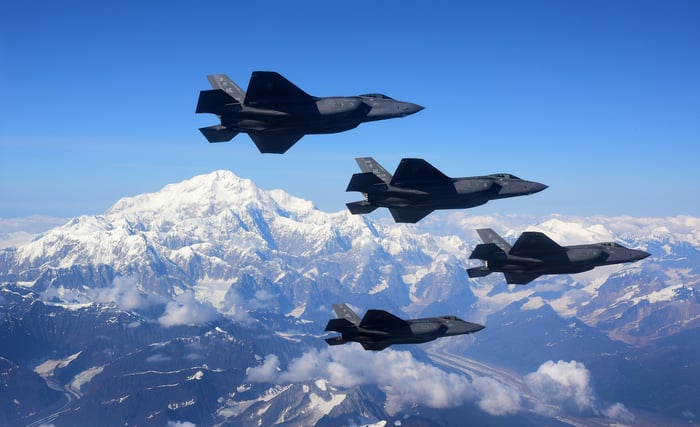Lockheed Martin (LMT -0.55%) delivered mostly bad news during its third-quarter earnings release, sending investors running for the exits. The defense titan fell short of analyst expectations on sales, and warned to expect further sluggish growth in the quarters ahead.
The news wasn't all bad, and Lockheed Martin has a compelling story to tell if you focus on the pipeline and the opportunities for growth in the second half of the decade. But the company is in a period of transition and is going to need time to get its growth engine restarted.
Here's a look at the changing narrative from Lockheed Martin, and how investors should view the company from here.

Lockheed Martin's F-35 in flight. Image source: U.S. Air Force photo by Tech. Sgt. Jerilyn Quintanilla.
Sales growth has evaporated
Lockheed Martin reported earnings of $2.21 per share, down 65% year over year but ahead of analyst expectations for $1.97 per share in earnings. The decline was due largely to a $1.7 billion noncash pension charge related to the purchase of group annuity contracts.
Revenue is where Lockheed Martin really surprised investors. The company generated sales of $16 billion, down nearly 3% year over year and well shy of the $17.1 billion number analysts had expected. All four of Lockheed Martin's business units experienced sales weakness, with a long list of culprits including supply chain disruptions, F-35 production rate cuts, the U.S. withdrawal from Afghanistan, and the impact of the United Kingdom nationalizing management of its atomic weapons contributing to the decline.
Lockheed Martin warned the situation will not improve anytime soon. The company lowered its full-year revenue guidance to $67 billion, down from a previous range of $67.3 billion to $68.7 billion, and said its planned acquisition of Aerojet Rocketdyne Holdings (AJRD) would not close in 2021 as hoped due to regulatory concerns.
The company said it expects only modest revenue growth in 2022 as well, as programs including the Blackhawk helicopter and THAAD missile defense wind down.
"We have recently undertaken a reassessment of our five-year business plan given recent external and programmatic events," CEO James Taiclet said in statement. "Our conclusions, which are reflected in our updated 2021 guidance and subsequent trend information, reflect continuing strong cash flow generation, but a slight reduction in revenue in 2022 and roughly flat to low-single-digit growth rates in both revenue and segment operating profit over the next few years, with increasing growth opportunities in the years that follow."
The pipeline will produce... eventually
As Taiclet notes, Lockheed remains optimistic about some of the opportunities that are on the horizon. The company has several classified programs that it expects to move from development into production between 2023 and 2026. While none are likely to be as large of a franchise as the F-35, there are likely potential multibillion opportunities under wraps including the possibility of a new Air Force fighter.
Lockheed Martin also remains at the forefront of hypersonics -- missiles that travel at least five times the speed of sound. And the company is a finalist for opportunities including two massive Army helicopter competitions, a new Air Force tanker aircraft, and the "Next Generation Interceptor" missile defense program.
None of those competitions are easy wins. I expect Textron to take at least one of the helicopter bakeoffs, and a pairing of Northrop Grumman and Raytheon Technologies appears to be the favorite for the NGI. Boeing has struggled with its existing tanker business and the Air Force might be looking to diversify, but Boeing will put up a fight. That leaves the second Army helicopter bid as perhaps the only major competition Lockheed is favored to win, and the company has submitted an innovative, but so far unproven, design into that competition.
Even without those competitions, expected upticks in spending on the CH-53K heavy lift helicopter, F-35 maintenance and sustainability, as well as multiple hypersonic programs expected to go into production between 2023 and 2026, in addition to those classified programs, should provide fuel for growth looking out 18 to 24 months.
Shifting from growth to income
Lockheed Martin is asking investors to be patient while those new growth opportunities materialize. The good news is the company is willing to pay up to secure that patience, earmarking a large portion of the $15 billion in free cash flow it expects to generate in the years to come for shareholders.
Following the post-earnings decline the stock now offers a dividend yield above 3%, and the stock looks affordable trading at just 13 times projected earnings, a 200-basis point discount to Northrop Grumman. The company also could repurchase up to $6 billion worth of its shares in the next 12 to 18 months, or nearly 7% of the total float at current prices.
For patient buy-and-hold investors, there is a lot to like about the potential for Lockheed Martin's portfolio over the next 10 years. But it is equally hard to see a catalyst that will cause the stock to jump in the near term. Until that changes, Lockheed Martin shares appear a better choice for income-minded investors than for those seeking market-beating growth.





